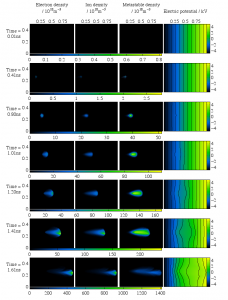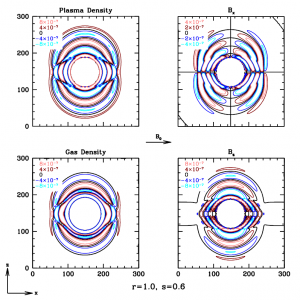
Fig 1: Evolution of the electron avalanche in a 1 mm gap of atmospheric pressure nitrogen with an electric field of 12 MV/m.
In low temperature, non-equilibrium plasmas, there is a continuous interaction between charged and neutral species, on a wide range of timescales. The shortest timescale is the ionization wavefront, and we have numerical simulations (using PIC codes) of electron avalanches at atmospheric pressure. An example of our simulation work is shown opposite (Fig 1), in which an initial electron-ion pair is accelerated in a strong electric field, resulting in avalanche in air (more correctly, atmospheric pressure nitrogen). The evolution of the populations of electrons, nitrogen ions, nitrogen metastable molecules and the total electric field is shown as snapshots at various different times. Full details can be found in our paper: MacLachlan, C. S.; Potts, H. E.; Diver, D. A. Plasma Sources Science & Technology Volume: 22 Issue: 1 Published: 2013
On a longer fluid timescale, neutral gas – ionized plasma interactions can be characterised by a momentum exchange, where the relative flow of one medium influences the development of the other. In a finite-difference fluid solver, we model the fluid interactions between a magnetised fluid plasma (mhd plasma) and an ideal neutral gas. The normal modes of each isolated medium are modified by the interaction, and the ensemble shows a hybrid evolution. In particular, pressure variations in the neutral gas can trigger magnetic perturbations in the plasma, since the longitudinal acoustic motion of the gas entrains a similar momentum in the plasma, leading to changes in the magnetic field.
 An example of our fluid simulation is shown in Fig 2, where the plasma (density given in top left), modifies strongly an initially uniform harmonically driven gaussian perturbation in the neutral gas (bottom left). More detail can be found in Diver, Potts & Teodoro, New Journal of Physics Volume: 8 (2006).
An example of our fluid simulation is shown in Fig 2, where the plasma (density given in top left), modifies strongly an initially uniform harmonically driven gaussian perturbation in the neutral gas (bottom left). More detail can be found in Diver, Potts & Teodoro, New Journal of Physics Volume: 8 (2006).